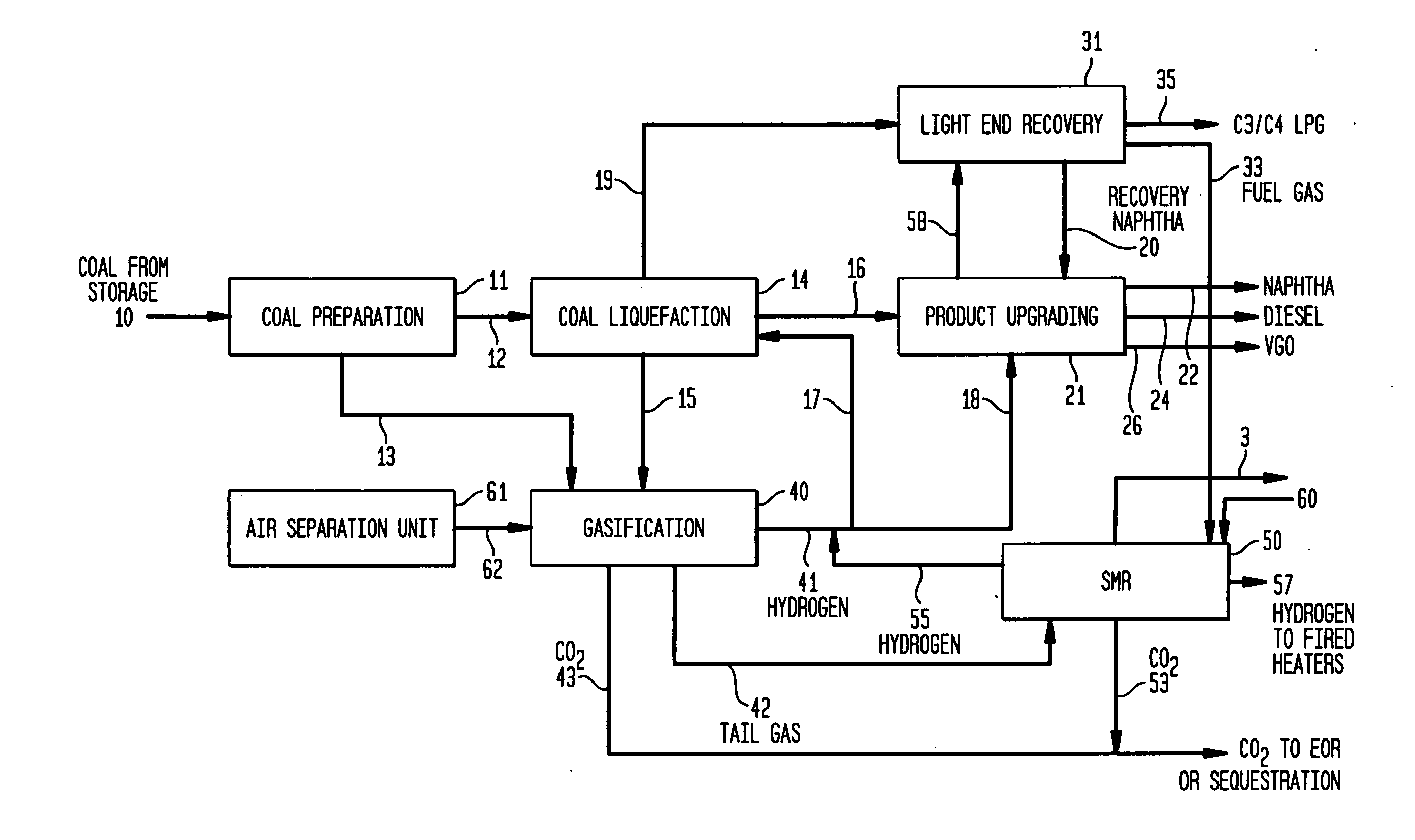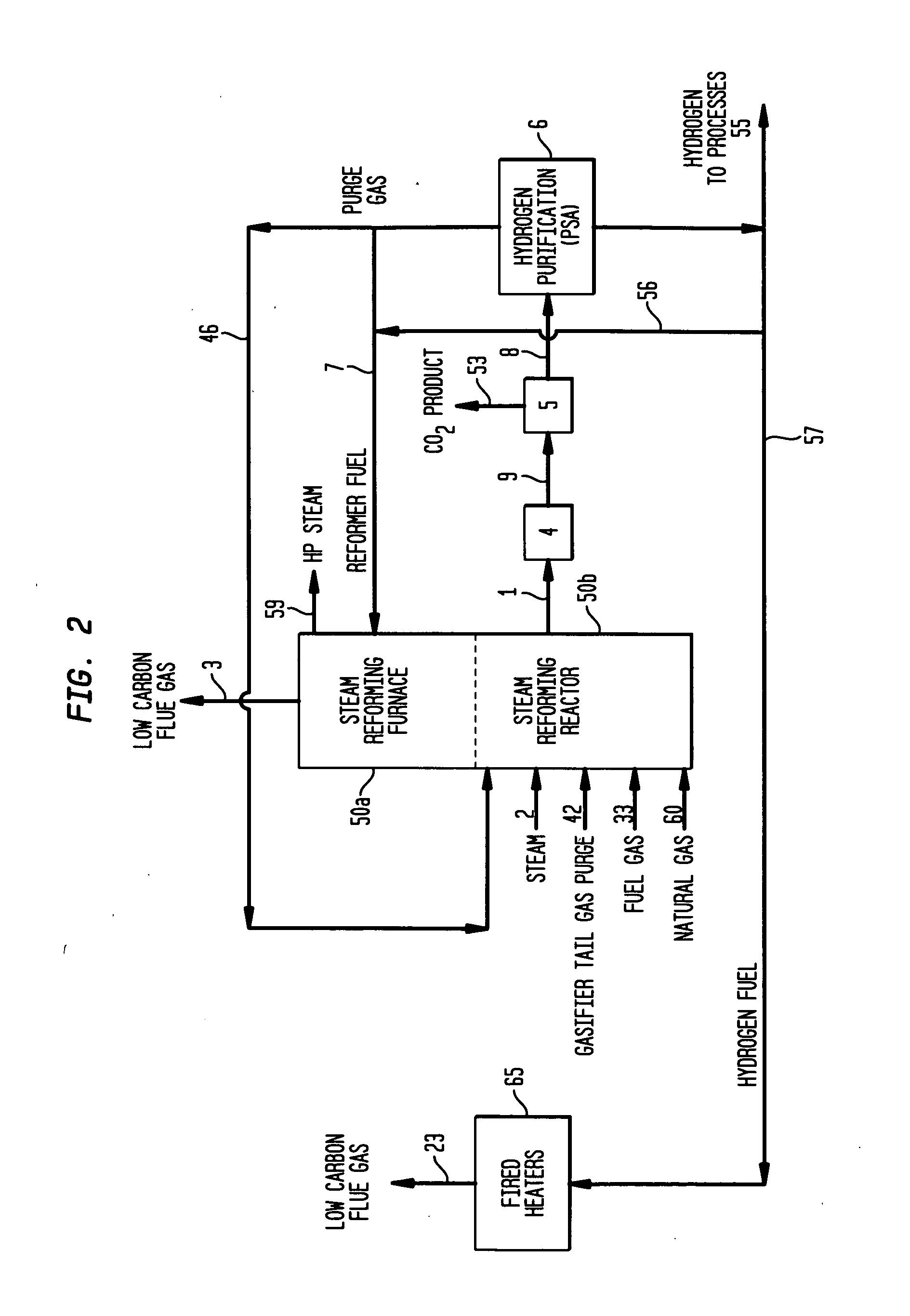Coal liquefaction complex with minimal carbon dioxide emissions
a technology of carbon dioxide emission and coal liquefaction complex, which is applied in the direction of combustible gas production, combustible gas purification/modification, energy input, etc., can solve the problems of low thermal efficiency, low cost, and low economic benefits of coal liquefaction, so as to reduce the carbon dioxide emissions of the plant and enhance oil recovery
- Summary
- Abstract
- Description
- Claims
- Application Information
AI Technical Summary
Benefits of technology
Problems solved by technology
Method used
Image
Examples
case 1
[0061]The unconverted coal, heavy liquefaction residue and supplemental coal are fed to a gasification plant to provide plant hydrogen. Fuel gas is produced from the H-CoalTS Unit, secondary hydroprocessing units and the gasification PSA tail gas.
[0062]In the pre-invention case, CO2 capture is utilized in the gasification plant to attain approximately 87% capture of the total CO2 produced in the gasification plant and 75% of the total liquefaction facility. The plant fired heaters are fueled by a blend of the gasifier tail gas and process generated fuel gases. There is no SMR Unit in the pre-invention case with all hydrogen generated via gasification of the H-Coal bottoms and supplemental coal. A summary of the key plant inputs and products is shown in Table 1. As shown in the table, the pre-invention case requires 1,972 STPD of supplemental coal feed to gasification to provide the total plant hydrogen requirements (224 mM SCFD). The total CO2 emitted to the atmospheric is 2,847 STP...
case 2
[0063]In the case that utilizes Applicant's invention, a SMR Unit is added to process fuel gas from the plant, tail gas purge from the pressure swing absorber unit in the gasification complex, and tail gas from the pressure swing absorber unit that is part of this SMR unit to produce hydrogen and capture the CO2 produced
[0064]The SMR furnace is fed by SMR produced hydrogen and a small quantity of the SMR PSA tail gas. Details of the invention case SMR Unit operation are shown in Table 2. As shown in the table, 137.5 mM SCFD of hydrogen (99.9 V % purity) is produced in the SMR Unit. This hydrogen is used as follows: 55.0 mM SCFD to the SMR furnace, 55.6 mM SCFD to the liquefaction complex fired heaters (in place of fuel gas), and 26.9 mM SCFD to process plants including the liquefaction reactors. The latter hydrogen reduces that required from the gasifier and results in lower supplemental coal required. As shown in Table 1, the supplemental coal to the gasifier is reduced from 1,972 ...
PUM
| Property | Measurement | Unit |
|---|---|---|
| temperatures | aaaaa | aaaaa |
| temperatures | aaaaa | aaaaa |
| temperatures | aaaaa | aaaaa |
Abstract
Description
Claims
Application Information
 Login to View More
Login to View More - R&D
- Intellectual Property
- Life Sciences
- Materials
- Tech Scout
- Unparalleled Data Quality
- Higher Quality Content
- 60% Fewer Hallucinations
Browse by: Latest US Patents, China's latest patents, Technical Efficacy Thesaurus, Application Domain, Technology Topic, Popular Technical Reports.
© 2025 PatSnap. All rights reserved.Legal|Privacy policy|Modern Slavery Act Transparency Statement|Sitemap|About US| Contact US: help@patsnap.com



